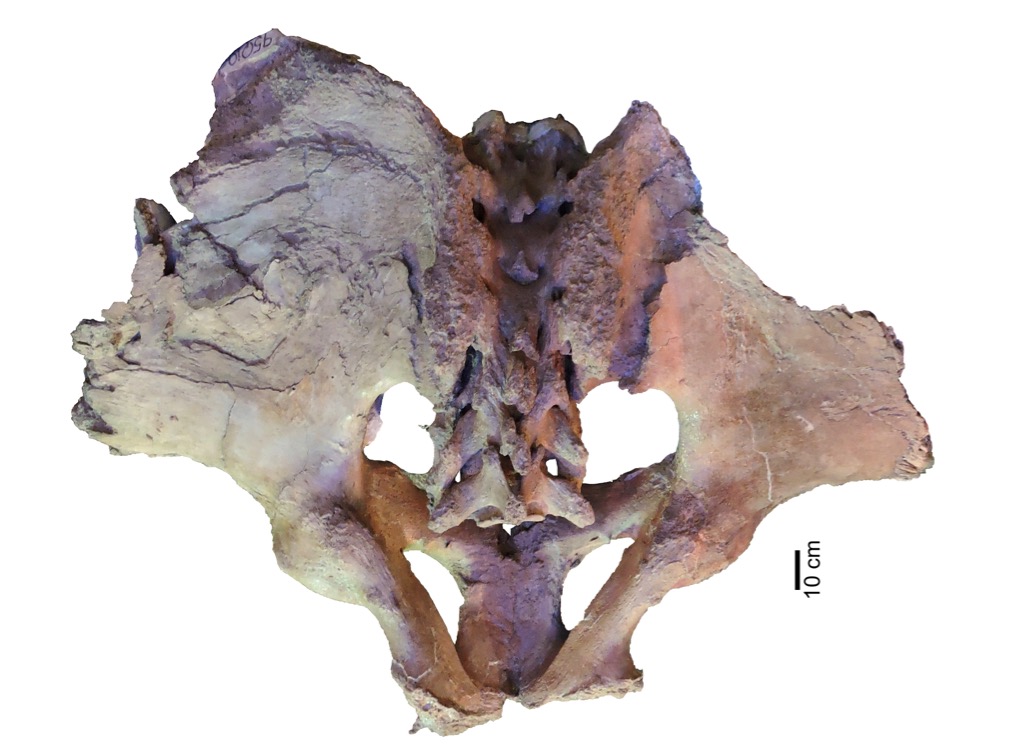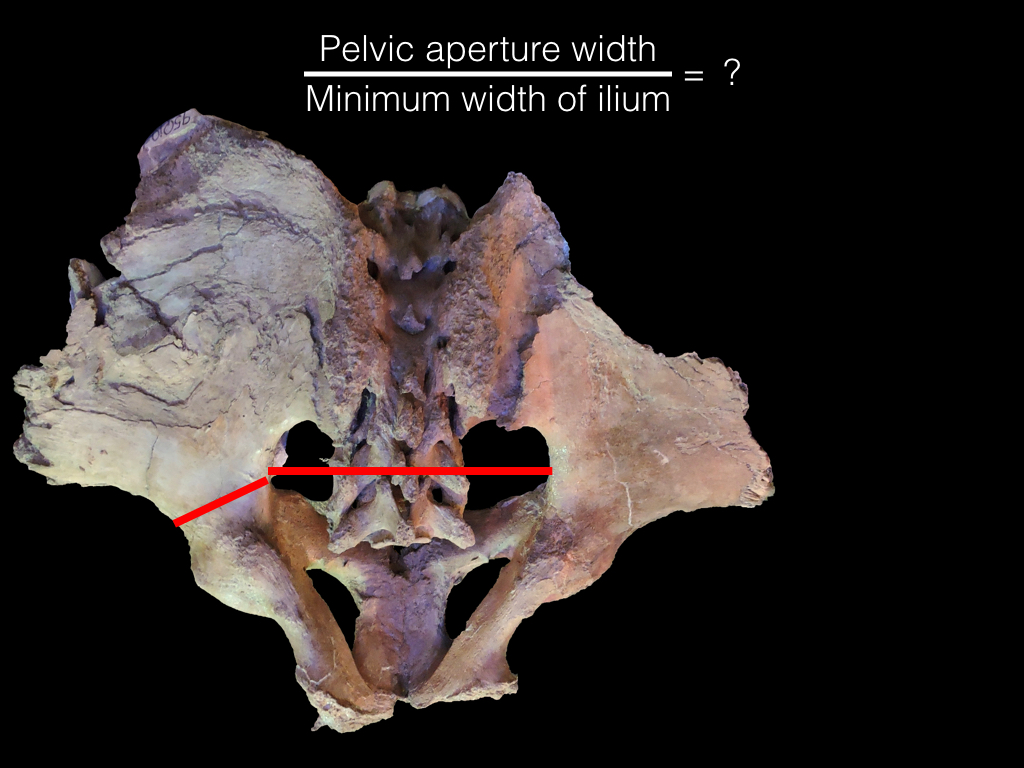 Western Science Center's largest mastodon, Max (@MaxMastodon on Twitter) has been getting a lot of attention over the last year. Besides getting CT scans and figuring prominently in the "Mastodons of Unusual Size" project, this October marks 21 years since Max was discovered. Max is also one of the WSC's major exhibits, and at our recent Science Under the Stars fundraiser we successfully raised funds to add new content to Max's (and other) displays, discussing some of the new things we've learned.Max is not only the largest mastodon known from California, but is also pretty large when compared to mastodons from other parts of the country, so we've long assumed he was male (male mastodons tend to be larger than females). But there are several parts of the skeleton where we can take direct measurements to have greater confidence when identifying Max's sex. One of these areas is the pelvis, which as I've discussed in a prior post is one of the well-preserved parts of Max.Lister (1996) showed that in mammoths males and females consistently differ in the ratio between two pelvic measurements, the pelvic aperture width and the minimum width of the ilial shaft, as shown in the image below:
Western Science Center's largest mastodon, Max (@MaxMastodon on Twitter) has been getting a lot of attention over the last year. Besides getting CT scans and figuring prominently in the "Mastodons of Unusual Size" project, this October marks 21 years since Max was discovered. Max is also one of the WSC's major exhibits, and at our recent Science Under the Stars fundraiser we successfully raised funds to add new content to Max's (and other) displays, discussing some of the new things we've learned.Max is not only the largest mastodon known from California, but is also pretty large when compared to mastodons from other parts of the country, so we've long assumed he was male (male mastodons tend to be larger than females). But there are several parts of the skeleton where we can take direct measurements to have greater confidence when identifying Max's sex. One of these areas is the pelvis, which as I've discussed in a prior post is one of the well-preserved parts of Max.Lister (1996) showed that in mammoths males and females consistently differ in the ratio between two pelvic measurements, the pelvic aperture width and the minimum width of the ilial shaft, as shown in the image below: In female mammoths, this ratio is greater than about 2.6, while it is less than 2.6 in males. Hodgson et al. (2008) and Fisher (2008) found that a similar relationship holds true for mastodons. In Max this ratio is 2.23, which is well on the male end of the spectrum. This is, of course, what we expected to find, but it's still necessary to go through the steps and confirm the results, rather than just assuming we'll get the expected answer.One of the new interactive stations funded by our Science Under the Stars fundraiser is going to feature the methods we used to determine Max's sex, including pelvic dimensions. Below is a draft video explanation of the pelvic measurements we put together for the fundraiser, narrated by WSC volunteer Catalina Lauridsen:[youtube https://www.youtube.com/watch?v=Zu4rOYtp9Ng]Tomorrow at WSC we're hosting the first Ice Age Soirée, and over-21 party celebrating 21 years since Max's discovery. Tickets are $40 and include dinner and drinks, as well as admission to the museum.References:Fisher, D. C., 2008. Taphonomy and paleobiology of the Hyde Park mastodon. In Allmon, W. D. and Nester, P. L., eds. Mastodon Paleobiology, Taphonomy, and Paleoenvironment in the Late Pleistocene of New York State: Studies on the Hyde Park, Chemung, and North Java Sites. Paleontographica Americana 61:197-289.Hodgson, J. A., Allmon, W. D., Nester, P. L., Sherpa, J. M., and Chimney, J. J., 2008. Comparative osteology of Late Pleistocene mammoth and mastodon remains from the Watkins Glen Site, Chemung County, New York. In Allmon, W. D. and Nester, P. L., eds. Mastodon Paleobiology, Taphonomy, and Paleoenvironment in the Late Pleistocene of New York State: Studies on the Hyde Park, Chemung, and North Java Sites. Paleontographica Americana 61:301-367.Lister, A. M., 1996. Sexual dimorphism in the mammoth pelvis: an aid to gender determination. In Shoshani, J. and Tassy, P. eds. The Proboscidea: Evolution and Paleoecology of Elephants and their Relatives. Oxford University Press, pp.254-259.
In female mammoths, this ratio is greater than about 2.6, while it is less than 2.6 in males. Hodgson et al. (2008) and Fisher (2008) found that a similar relationship holds true for mastodons. In Max this ratio is 2.23, which is well on the male end of the spectrum. This is, of course, what we expected to find, but it's still necessary to go through the steps and confirm the results, rather than just assuming we'll get the expected answer.One of the new interactive stations funded by our Science Under the Stars fundraiser is going to feature the methods we used to determine Max's sex, including pelvic dimensions. Below is a draft video explanation of the pelvic measurements we put together for the fundraiser, narrated by WSC volunteer Catalina Lauridsen:[youtube https://www.youtube.com/watch?v=Zu4rOYtp9Ng]Tomorrow at WSC we're hosting the first Ice Age Soirée, and over-21 party celebrating 21 years since Max's discovery. Tickets are $40 and include dinner and drinks, as well as admission to the museum.References:Fisher, D. C., 2008. Taphonomy and paleobiology of the Hyde Park mastodon. In Allmon, W. D. and Nester, P. L., eds. Mastodon Paleobiology, Taphonomy, and Paleoenvironment in the Late Pleistocene of New York State: Studies on the Hyde Park, Chemung, and North Java Sites. Paleontographica Americana 61:197-289.Hodgson, J. A., Allmon, W. D., Nester, P. L., Sherpa, J. M., and Chimney, J. J., 2008. Comparative osteology of Late Pleistocene mammoth and mastodon remains from the Watkins Glen Site, Chemung County, New York. In Allmon, W. D. and Nester, P. L., eds. Mastodon Paleobiology, Taphonomy, and Paleoenvironment in the Late Pleistocene of New York State: Studies on the Hyde Park, Chemung, and North Java Sites. Paleontographica Americana 61:301-367.Lister, A. M., 1996. Sexual dimorphism in the mammoth pelvis: an aid to gender determination. In Shoshani, J. and Tassy, P. eds. The Proboscidea: Evolution and Paleoecology of Elephants and their Relatives. Oxford University Press, pp.254-259.
